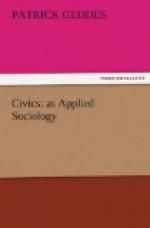Hence, after many years of experiment and practice in teaching sociology I still find no better method available than that of regional survey, historical as well as geographical. Beginning with some popular excursion of obvious beauty and romantic interest like that to Melrose, we see with every tourist how naturally and fully the atmosphere and tradition of the Border found its expression and world influence in Sir Walter Scott. Thence, passing by way of contrast through the long isolated peninsula of Fife, say to representative towns like Kirkcaldy and Largo, we still see the conditions of that individualism of which Adam Smith and Alexander Selkirk ("Robinson Crusoe”) have each in his way become the very prototypes. In such ways the connection of regional geography, history, and social psychology becomes increasingly clear. Again, we explore the other old Fife seaports, a series of survivals like those of the Zuyder Zee, or again work out in the field the significance of Stirling, so often the strategic centre of Scotland. Again, Dunfermline, as early mediaeval capital and abbey, furnishes a convenient object lesson preparatory to the study of the larger Edinburgh. Here, again, its triple centre, in the port of Leith, the Royal Castle, the Abbey of Holyrood, are the respective analogues of the port of London, the Tower, and Westminster; while each city-group has its outlying circle of minor burghs, tardily and imperfectly incorporated into a civic whole. Again, such a marked contrast of civic origins and developments as those of Glasgow and Edinburgh has to be accounted for; and thus through such progessively complexer surveys we reach the plane of modern civic problems and policies. Understanding the present as the development of the past, are we not preparing also to understand the future as the development of the present?




